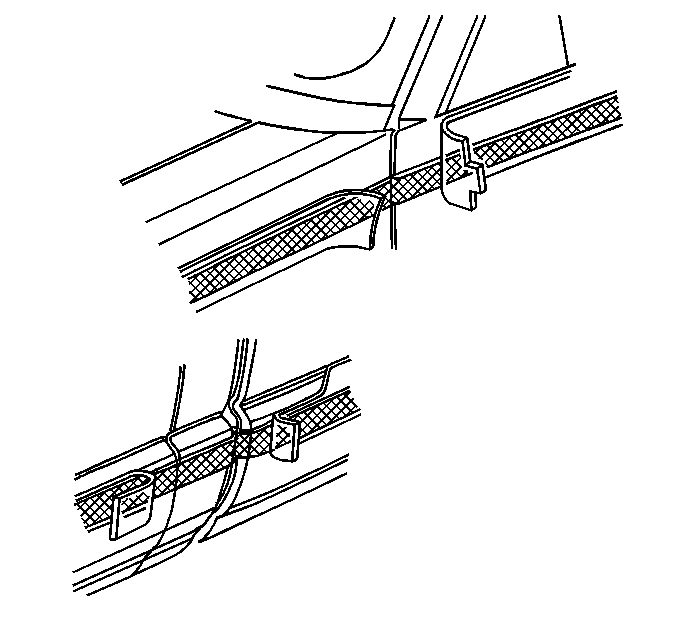Removal Procedure
Important: Stripes and decals adhere to a painted surface using pressure sensitive
adhesive. The use of a wetting solution aids the technician in lifting and
positioning the stripe or decal during installation. A wetting solution
also ensures a better bond between stripe or decal and panel. Stripe
or decal replacement involving collision damage, or damage to underlying
painted surface, requires that metal repair and/or refinish operations
be completed before the stripe or decal is installed. Freshly painted
surfaces must be allowed to dry thoroughly before installing stripe
or decal. Residual solvents in fresh painted surfaces can lead to subsequent
blistering problems if stripe or decal is applied before complete release
of solvents. The striping material highlights vehicle surface imperfection.
All dings, rough metal, paint defects and uneven two-tone paint breaklines
mu
The following equipment and materials are necessary when making a quality
stripe or decal installation. • Body surfaces and decals must be maintained between 21 to 38°C
(70 to 100°F) during installation. • Never apply decals when body surface and decal temperatures are
below 21°C (70°F). • Stripes and decals may be applied dry. If this does not result
in a consistent bubble free application, the ``wet'' method must be used
as in the case of large graphics packages. • Stripes or decals that are applied on flexible surfaces (fascias,
etc.) must be applied using the WET method. This will reduce the formation
of bubbles under the decal due to the outgassing potential of the flexible
materials. Equipment and Materials
• Heat Gun. • Wetting solution - a foaming type window cleaner, that does not
contain ammonia. • Isopropyl alcohol. • Varnish Makers and Painters (VM&P) naphtha. • Squeegee - 100 mm (4 in) wide, plastic
or hard rubber. Deburr any sharp or rough edges on the squeegee to prevent scratching
of the stripe or decal. • Water bucket and sponge or spray bottle. • Sandpaper - 800 grit or finer, wet or dry type. • Clean, lint-free wiping cloth. • Sharp knife or razor blade. • Scissors. • Fine pin or needle. • Marking pencil.
- Remove the necessary molding or trim panel.
- Remove the molding attaching clips, handles, sidemarker reflector, and/or other stripe or decal overlapping parts.
- Wash and clean repair surfaces, adjacent panel, and openings as required.
- Remove the stripe or decal from body panel using 3M™ scotch brite molding adhesive remover disk 3M™ P/N 07501 or equivalent.
- Remove all traces of adhesive residue from painted surfaces with a Varnish Makers and Painters (VM&P) naphtha.

Notice: To avoid damaging the paint finish, do not use pointed or sharp instruments to remove the stripe or the decal.
Notice: Use of harsh chemicals when cleaning can damage exterior lamps. Suggested cleaners are a mild soap and water, or Varnish Makers and Painters (VM&P) Naptha. VM&P Naptha is a specific type of naptha and should not be substituted by any other naptha.
Installation Procedure
- Prepare the surface.
- Clean the painted surface with Varnish Makers and Painters (VM&P) naphtha.
- Clean the area where the stripe or decal will be applied with a 50/50 mixture of isopropyl alcohol and water.
- Wipe the panel surface with a clean cloth while solvent is still wet and allow to dry.
- Apply the wetting solution to area where stripe or decal is to be installed.
- Remove the backing material of the stripe or decal as necessary.
- Put the wetting solution on adhesive side of the stripe or decal.
- Apply the stripe or decal to the panel.
- Working from center where possible, squeegee the stripe or decal into position.
- Apply heat to the stripe or decal at recessed areas.
- Inspect the stripe or decal from critical angle using adequate light reflection to detect any irregularities that may have developed during installation.
- Remove all air bubbles by piercing with a safety pin, needle, or tool with same size piercing tip.
- Install previously removed parts.
- Clean panel as require.
Notice: To prevent possible vehicle, stripe or decal damage, always refer to manufacturer's packaged instructions.
Notice: Striping material highlights vehicle surface imperfection. All dings, rough metal, paint defects and uneven two-tone paint breaklines must be eliminated before stripe/decal application. Freshly painted surfaces must be allowed to dry thoroughly before installing stripe or decal. Residual solvents in fresh painted surfaces can lead to subsequent blistering problems if stripe or decal is applied before complete release of solvents.
If the area where stripe or decal is to be applied has been refinished, remove any imperfections that would show through stripe or decal.
Notice: Use of harsh chemicals when cleaning can damage exterior lamps. Suggested cleaners are a mild soap and water, or Varnish Makers and Painters (VM&P) Naptha. VM&P Naptha is a specific type of naptha and should not be substituted by any other naptha.

Do not touch the adhesive backing of the stripes or decal.
The wetting solution will allow movement of the stripe or decal for proper positioning.
Application of additional wetting solution may be necessary to ease the installation of stripe or decal. Application of soapy wetting solution on top side of stripe or decal will ease pull of squeegee on stripe or decal and help to eliminate damage to it.
Press stripe or decal into the recess to obtain firm bond.
| • | Pierce bubble on its outer edge and force air out from opposite edge with blade of squeegee. |
| • | Never use razor blade or knife edge. |
